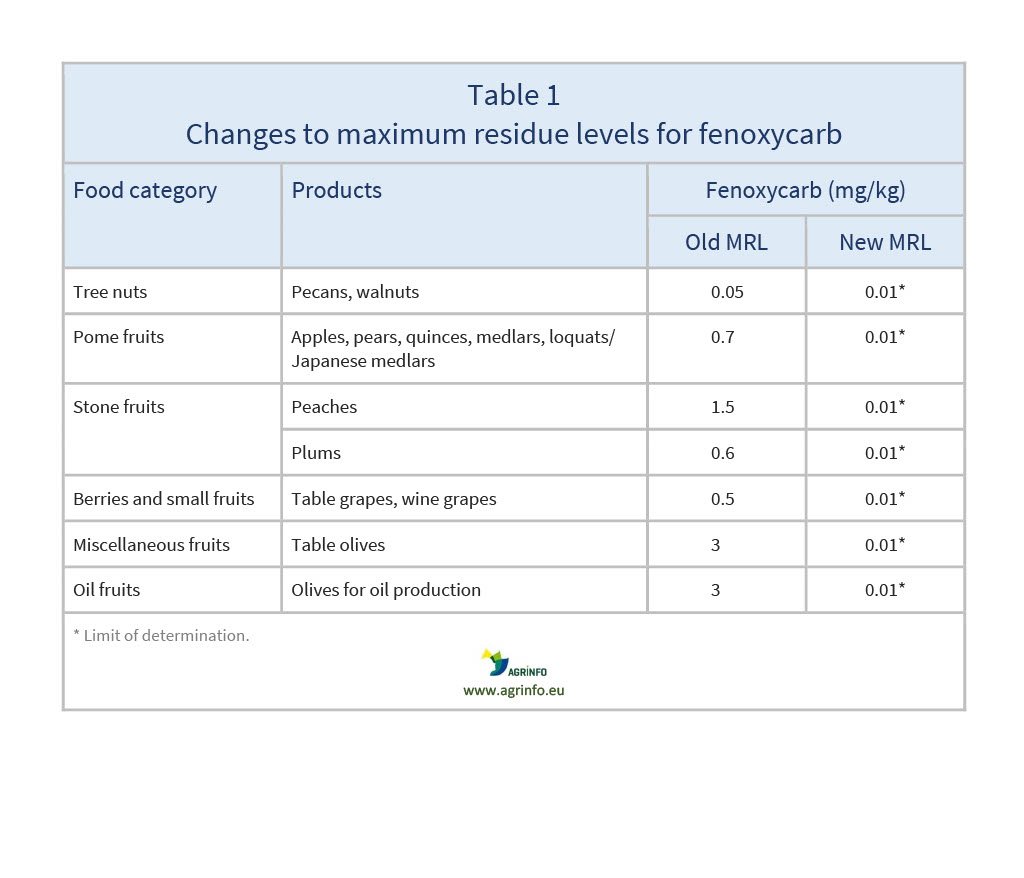Maximum residue levels for fenoxycarb
- Food safety
- Pesticide MRLs
- Pesticides
Summary
The EU has set the MRLs for fenoxycarb on all products to the limit of determination (LOD, the lowest level that can be detected using the most modern and reliable analytical methods). There will be potential impacts on exporters of pecans, walnuts, apples, pears, quinces, medlars, loquats/ Japanese medlars, peaches, plums, table grapes, wine grapes, table olives, and olives for oil production.
EU reduces MRLs for fenoxycarb to the limit of determination on all products
Commission Regulation (EU) 2024/341 of 22 January 2024 amending Annexes II and V to Regulation (EC) No 396/2005 of the European Parliament and of the Council as regards maximum residue levels for diethofencarb, fenoxycarb, flutriafol and pencycuron in or on certain products
Update
The EU has set the MRLs for fenoxycarb on all products to the limit of determination (LOD, the lowest level that can be detected using the most modern and reliable analytical methods). There will be potential impacts on exporters of pecans, walnuts, apples, pears, quinces, medlars, loquats/ Japanese medlars, peaches, plums, table grapes, wine grapes, table olives, and olives for oil production.
Impacted Products
pecans, walnuts, apples, pears, quinces, medlars, loquats/ Japanese medlars, peaches, plums, table grapes, wine grapes, table olives, olives for oil production
What is changing?
The EU has amended the MRLs for fenoxycarb as summarised in Table 1.
Why?
The approval for fenoxycarb has not been renewed as the manufacturer did not submit a new application for approval. Therefore fenoxycarb is no longer authorised in the EU, and all MRLs are set at the LOD.
Timeline
The new MRLs will apply from 12 August 2024. Products exported to the EU before 12 August 2024 that comply with the old MRLs will not be removed from the EU market after 12 August, even if they do not comply with the new MRLs.
Recommended Actions
Exporters of the nuts and fruits listed in Table 1 should review their current use of fenoxycarb and, where necessary, look for potential alternative solutions.
Background
MRLs are set in accordance with the rules set out in Regulation 396/2005. For information on current MRLs for other substances, please consult the EU Pesticide Residues database.
Sources
Commission Regulation (EU) 2024/341
Tables & Figures

Source: Regulation 2024/341
Disclaimer: Under no circumstances shall COLEAD be liable for any loss, damage, liability or expense incurred or suffered that is claimed to have resulted from the use of information available on this website or any link to external sites. The use of the website is at the user’s sole risk and responsibility. This information platform was created and maintained with the financial support of the European Union. Its contents do not, however, reflect the views of the European Union.
EU reduces MRLs for fenoxycarb to the limit of determination on all products
Commission Regulation (EU) 2024/341 as regards maximum residue levels for diethofencarb, fenoxycarb, flutriafol and pencycuron in or on certain products
What is changing and why?
The approval for fenoxycarb in the EU has not been renewed as the manufacturer did not submit a new application for approval. Therefore fenoxycarb is no longer authorised in the EU, and all MRLs are set at the limit of determination (LOD). Changes to the maximum residue levels (MRLs) for fenoxycarb are set out in Table 1.
Actions
Suppliers of the nuts and fruits listed in Table 1 should explore alternative solutions to their current use of fenoxycarb.
Timeline
The new MRLs will apply from 12 August 2024. Products exported to the EU before 12 August 2024 that comply with the old MRLs will not be removed from the EU market after 12 August, even if they do not comply with the new MRLs.
Tables & Figures

Source: Regulation 2024/341
Disclaimer: Under no circumstances shall COLEAD be liable for any loss, damage, liability or expense incurred or suffered that is claimed to have resulted from the use of information available on this website or any link to external sites. The use of the website is at the user’s sole risk and responsibility. This information platform was created and maintained with the financial support of the European Union. Its contents do not, however, reflect the views of the European Union.
